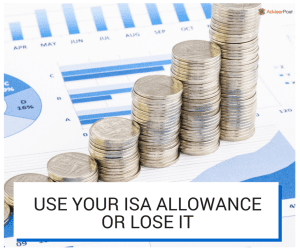


Use Your ISA Allowance Or Lose It
The phrase “use it or lose it” is very relevant to ISAs. As of April 6th 2015 you have 366 days to save up to £15,240 in your ISA. Even though 2016 is a leap year, giving you an extra day to achieve this, it’s recommended to get off the starting blocks quickly. Let’s cover the basics first.
What Is An ISA?
ISA stands for Individual Savings Account. In very simple terms, you pay into an ISA out of your post-tax income. You can either keep this money as cash or use it to buy investments. You should know that there is a government-defined list of ISA-approved investments and you have to choose from these. Having said that, the list is pretty extensive, so you have a good chance of finding something to suit you. If you keep it as cash then the interest you earn is tax-free. Generally speaking income earned from investments is also tax-free, but there are some exceptions to this.
How Does An ISA Work?
You pay into an ISA in the same way as you pay into any other bank account. As previously mentioned the amount you can deposit in any one year is capped. It’s important to understand that this cap relates to the amount deposited rather than the amount in the account at the end of the tax year. In other words, if you withdraw money, you can’t just put it back later. Otherwise ISAs work much the same way as a standard savings account or as an investment-funding account. You can even use the same ISA for both purposes, dividing your money as you see fit.
Do I Have to Pay into An ISA in One Go?
No, you can save over the course of the year if you want to. Alternatively you can pay in a lump sum if that suits you better.
What’s The Difference Between ISAs And NISAs?
Last year ISAs were given a revamp. In short the limits were increased and they were made more flexible. For a while these new-format ISAs were referred to as NISAs. Sometimes they still are, but the term ISA is also in common use. There’s a limit to how long something can really be considered new.
How Do I Save into A NISA/ISA?
The short answer is however it suits you best. If you have a regular income, you can set up a standing order to ensure that your ISA is topped up when you get paid. If your income fluctuates you can deposit money throughout the year as you have it spare. Alternatively you could save into a regular savings account throughout the year and transfer a lump sum at the end of the tax year. That way you can take out and replace money without any penalties.
How can I make the most of my NISA/ISA?
Quite simply the more you put in, the more you can potentially get out. In other words, if you possibly can, use your whole ISA allowance.
If you were unable to max out your ISA last year, now may be a good time to reflect on why that was. If you simply didn’t have the money, then that’s fair enough. Is there anything you could do to make your income go a little further this year? Maybe now would be a good time to review the family finances and run a keen eye over your household budget. If you did have the money but didn’t put it into an ISA, what specifically stopped you? Did you just forget? If so a standing order may be the answer. Alternatively you could set a reminder on your phone or calendar to double-check if you should be making a deposit.
The tax efficiency of ISAs is based on current rules. The current tax situation may not be maintained. The benefit of the tax treatment depends on individual circumstances. The value of your investment and any income from it may fall as well as rise and you may get back less than you invested.
https://www.moneyadviceservice.org.uk/en/articles/cash-isas
https://www.moneyadviceservice.org.uk/en/articles/stocks-and-shares-isas




